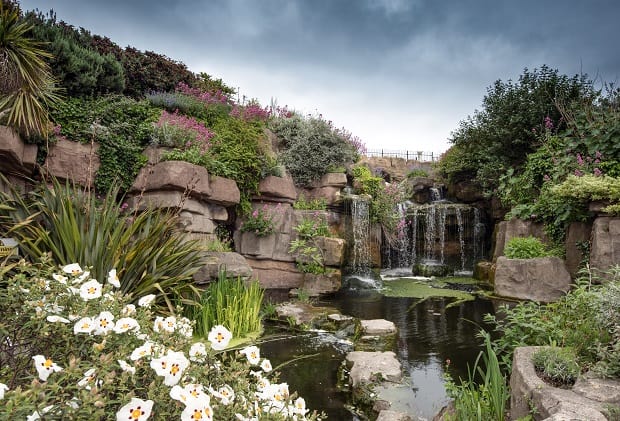
A five year scheme in Ramsgate aimed at bringing new life into historic places has reached its conclusion.
The Heritage Action Zone project was launched to help areas that are rich in heritage but needed a boost to make them more attractive to residents, businesses, visitors and investors.
In 2017 Ramsgate was chosen as one of the country’s first ‘Heritage Action Zones’, in the nationwide scheme from Historic England, with funding of £400,000 over five years, to be matched by £10,000 a year from Ramsgate Town Council.
Using the heritage in the town, which has 442 listed buildings, the project aimed to attract new investment into Ramsgate and create apprenticeships, boost tourism and involve schools and the community in exhibitions and heritage-related skills training.
Ramsgate was one of just 10 areas chosen for the HAZ status.
Thanet District Council has worked in partnership with Historic England, the Ramsgate Society, Ramsgate Coastal Community team, Ramsgate Town Council and the community on a range of projects within the HAZ.
Extensive research was undertaken to better understand the history, heritage, and changing face of the town and to understand what makes the heritage in Ramsgate so special.
As a direct result of HAZ funding nine historic sites gained listed status following a listed building review.
These are:
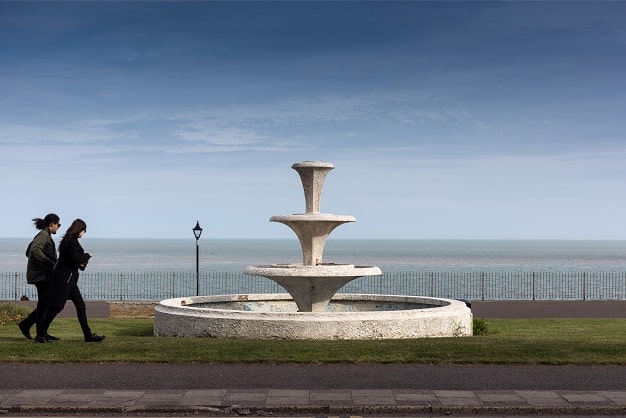
Festival of Britain Fountain, Victoria Parade, Grade II
The fountain on Victoria Parade, near the former Granville hotel, is the sole survivor of three fountains built as part of the Festival of Britain celebrations in Ramsgate in 1951. The Festival of Britain inspired activities and events around the country, including a ‘Festival of Light’ in Ramsgate. A central fountain in the inner harbour threw a jet of water 70ft into the air, illuminated by hanging coloured spotlights and floodlights, and two smaller fountains stood either side. The fountain is made from concrete and its dramatic outline was designed to reflect the spirit of the festival and to look to a brighter future.
Victoria Gardens Kiosk, Grade II
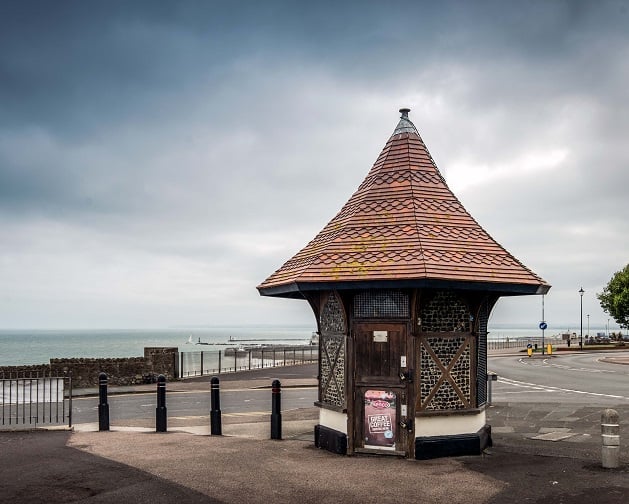
This octagonal seafront kiosk in Victoria Gardens, close to the former Granville Hotel, was built c.1876 in a picturesque Gothic style. Originally it was used as a ticket booth for visitors to the formal gardens and entertainments within the then enclosed Victoria Gardens – there was a small fee to enter. The private gardens concept was relatively short-lived and by 1900 the perimeter railings had been removed. By 1920 the kiosk was used to sell postcards and newspapers, a use that continued into the 21st century. Its change of use reflects the creation of today’s impressive seaside promenade from a series of formerly private spaces along the cliff tops.
Gateway to Barber’s Almhouses, Elms Avenue, Grade II
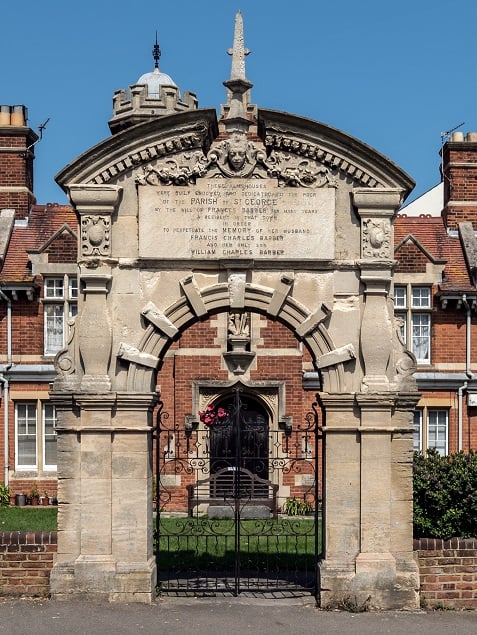
The stone gateway to the Barber’s Almshouses is now Grade II listed. Built in 1899, the Barber’s Almshouses were endowed and dedicated to the poor by the will of Frances Barber, who had lived in Ramsgate for many years. Mrs Barber died aged 82, and was respected for her philanthropic endeavours towards the poor and her generosity towards charitable institutions. The building – constructed in the memory of her husband, Francis Charles Barber and her son, William Charles Barber – accommodated 12 elderly people (ten women and two men) who received 7 shillings alms weekly.
Almshouses were powerful emblems of corporate status and private philanthropy in the 19th and 20th centuries. They were created to support those in need of welfare.
Clarendon House – Upper School for Chatham & Clarendon Grammar School, Grade II
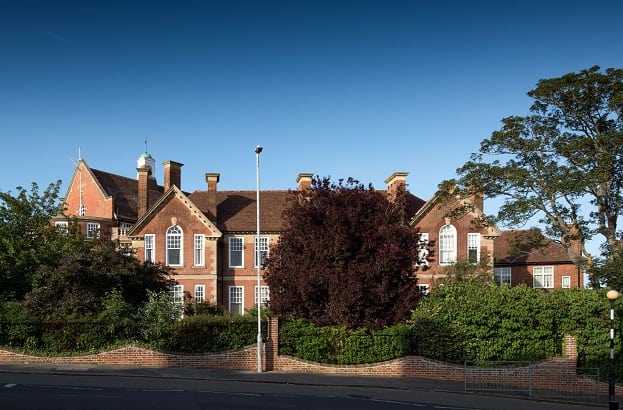
Clarendon House was purpose-built as a school in 1908-1909 at a cost of £11,222. It was one of more than 700 secondary schools built nationally following the 1902 Education Act, which transferred the responsibility for schools to local councils. It was established as a ‘dual school’, combining the Ramsgate County School for Girls and the newly formed Boys equivalent. The school grew rapidly after the First World War to become the largest public secondary school in Kent by 1921.
Clarendon House is a neo-Georgian red brick building with many original features surviving inside. There is a network of chalk-hewn tunnels beneath the school which were extended in the lead up to the Second World War to provide air raid shelter.
Aberdeen House, 68 Ellington Road, Grade II
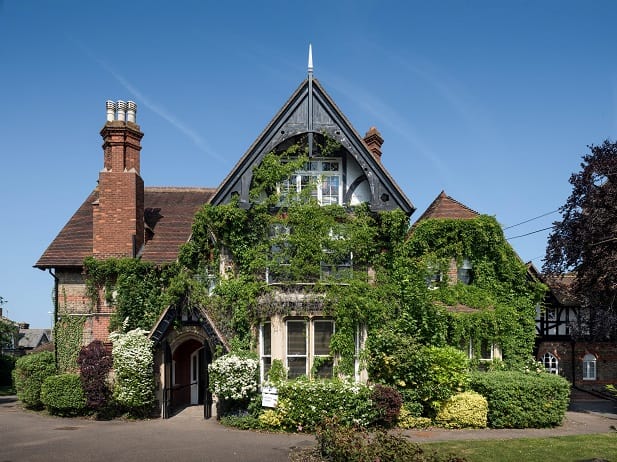
This former purpose-built boarding school has an unusual design because it integrated accommodation for the staff and students to make it feel more like a home. Aberdeen House was built for the Reverend George Simmers, a licensed preacher. He continued to be its headmaster until his death in 1918. Records show that ‘The instructions given to the architect were to provide a school house so thoroughly domesticated in its arrangements that the dominant ideas to the boys should be that of a comfortable home with all its accessories.’ The building was converted to a Registry Office in 1936 and is still in use.
Augusta Villa, Bellevue Road, Grade II
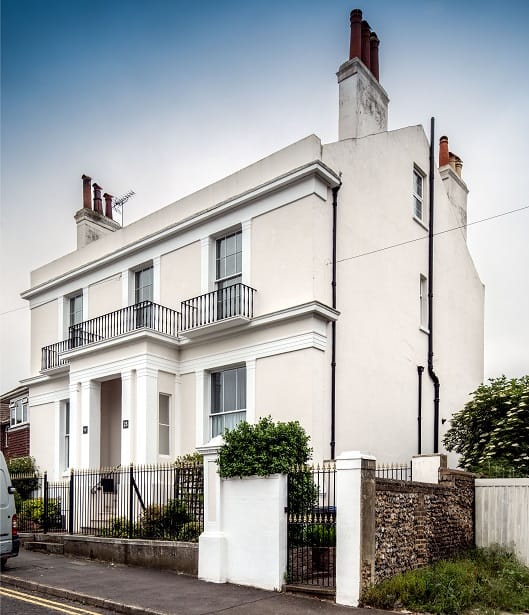
Augusta Villa on Bellevue Road is a Neo-Classical style house thought to have been designed around 1840 by George Gutch. Listed at Grade II, much of the original design and materials remain today.
Augusta Villa was an early part of the Mount Albion Estate development. The land was bought at auction by John M Gutch in 1838 and it is believed that he entrusted the design of this and two other villas to his brother George. Augusta Villa was formerly flanked by houses of a similar size and the three houses formed an impressive grouping along the eastern side of Arklow Square.
Castle Cottage, Upper Dumpton Park Road, Grade II
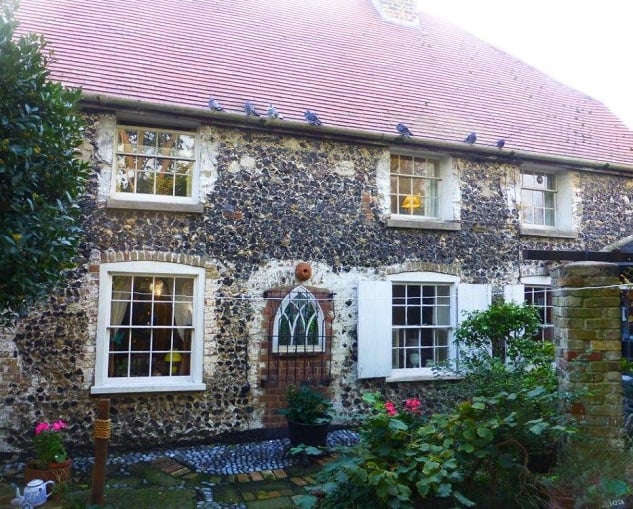
Castle Cottage dates from the 17th or 18th century. It is a rare surviving example of the agricultural nature of the land surrounding the port of Ramsgate. The cottage is largely made from flint with brick. The tile roof would once have been thatched. The name appears to have come from a large house called Townley Castle, which stood on a site nearby. Sadly, Townley Castle was bombed in the First World War and demolished as a result.
Former Wine and Spirit Merchants: 51 Queen Street, Grade II
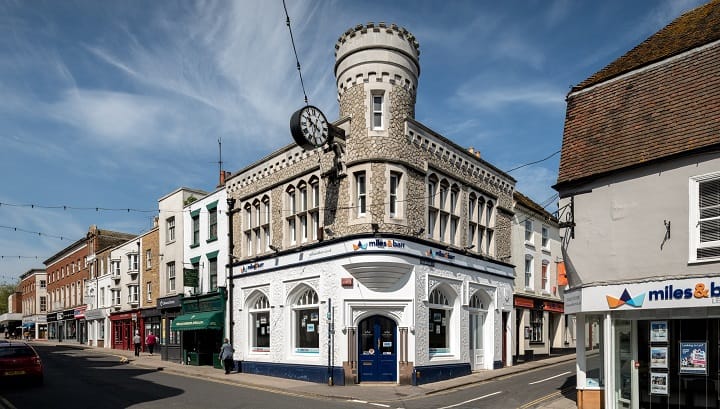
51 Queen Street, on the corner of Effingham Street, was built for wine and spirit merchants Gwyn and Co in 1898. It has high quality stone detailing across the façade and has decorative grapes and vines around the ground-floor windows. A stone shield can be found above the side door with ‘1778 JC 1898′, referring to the establishment of a wine business in Ramsgate by John Curling in 1778, helped by Ramsgate’s large ‘Royal’ harbour and nearness to France. The building has a prominent clock supported by a carved medieval-style figure.
NatWest Bank, 53 High Street, Grade II
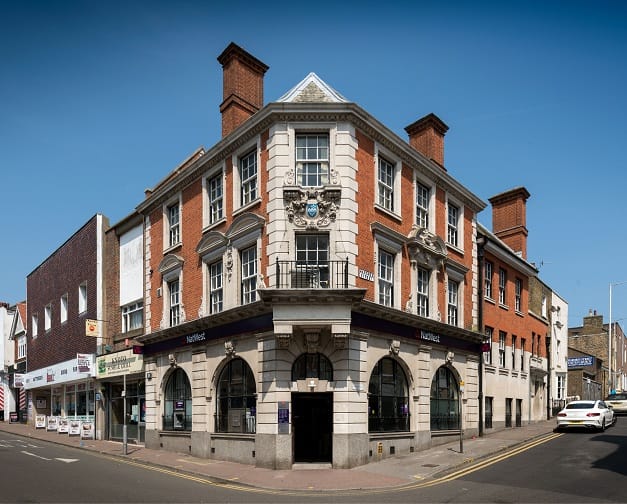
The NatWest Bank on the High Street was built in 1910-1911. Twentieth-century banks such as this were designed to be prominent on the high street, embodying solidity and respectability. Inside, the main entrance opens into the double-height banking hall. The ceiling retains two original, octagonal decorative plasterwork mouldings with fruit and foliage designs. A memorial plaque commemorates the members of staff who lost their lives during the First World War.
Upgraded
East Court, Brockenhurst Road, upgraded to Grade II* (from Grade II)
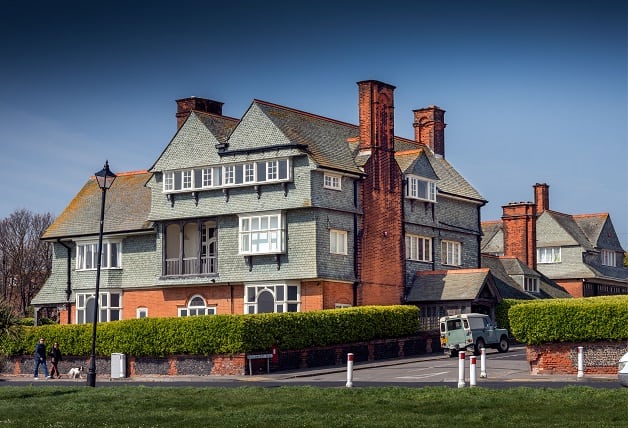
East Court in Brockenhurst Road is a grand villa, built in 1889-1890 for wealthy international businessman, Sir William Henry Wills and his wife. It has been upgraded to Grade II* because of its striking and original appearance, and a number of the original features of the building survive. The house was carefully designed as a holiday home, and its original layout as well as fixtures and fittings remain.
The house was owned by the Wills family until 1932, when it was inherited by Dame Janet Stancomb-Wills – the first female mayor of Ramsgate. She was also the patron of polar explorer Sir Ernest Shackleton who was a frequent visitor to the house.
Relistings
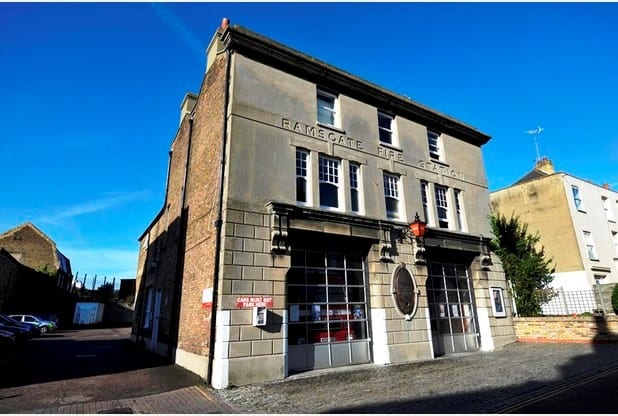
Ramsgate former Fire Station, Effingham Street
The former Granville Hotel on Victoria Parade
The Royal Victoria Pavilion
1-12 West Cliff Arcade
Madeira Walk rocks – five Pulhamite structures (artificial large-scale rock formations) which are spaced along the seafront at Ramsgate – built between 1893 and 1936
The scheme has also been responsible for the publication of ‘Ramsgate: The Town and its Seaside Heritage’, a book featuring beautiful new photography
Repairs made to the town’s Pulhamite or artificial rock, with training given to help local people look after it
Community consultation to review and update the Ramsgate Conservation area appraisal with the publication of a guide with practical advice for residents and businesses located within the conservation area.
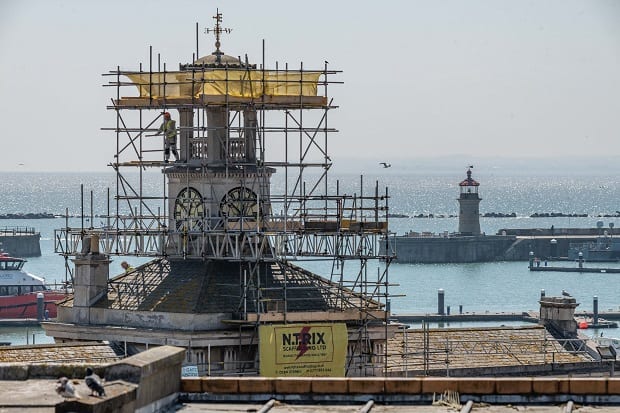
Roof repairs made to the iconic Ramsgate Clock House
Community engagement projects included:
Retiling of the public steps at Kent Place with Pugin-inspired tiles designed by Royal Harbour Academy students as part of Historic England’s Heritage Schools programme
Seafront Placemaking, an engagement project to understand how the local community use and value the seafront, including a memory-mapping exercise with interactive digital map and public exhibition
Podcast series created in partnership with the Ramsgate Festival of Sound which uncovers stories and experiences of the town through a sonic trail
Duncan Wilson, Chief Executive of Historic England, said: “Old and familiar places that are rich in heritage and full of promise have been invigorated to make them more attractive to residents, businesses, tourists and investors. This has been done through joint-working, grant funding and sharing Historic England’s skills and knowledge. Heritage is a powerful tool for delivering economic and social benefits and has an important role to play in levelling up. We look forward to continuing to create opportunities for local communities through our remaining Heritage Action Zone programmes.”
South Thanet MP Craig Mackinlay said: “It has been a pleasure working with the HAZ team and its community partners over the past five years. At risk historic assets have been identified and plans moved forwards on many fronts. Ramsgate’s Clock House now has a good part of its required funding guaranteed as part of the Levelling Up Fund for Ramsgate and now has a solid future.
“The involvement of youngsters and community groups throughout has ensured that more residents of Ramsgate have a greater appreciation of the unique heritage we have and what needs to be done to both preserve the past as these assets become our foundations for the future.”
Cllr Pugh, Deputy Leader and Cabinet Member for Economic Development at Thanet District Council, added: “The HAZ has laid the foundation for future heritage work, and has already helped to attract further funding which will continue to improve the town for all who live or work there, and for visitors too.
“The wide ranging community engagement activities have allowed us to build a lasting network of local stakeholders with a passion for community heritage projects. Over the next few years investment through the Ramsgate High Street Heritage Action Zone, the Future High Streets Fund and the Levelling Up Fund will continue to improve the public realm and key buildings, allowing its heritage to shine.”
A short film featuring interviews with some of the experts involved in the HAZ can be seen at: https://www.youtube.com/watch?v=isTxeYSxEzg

